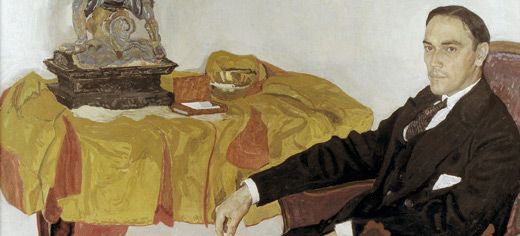
Lost Russian masterpieces from an art exhibition interrupted by the First World War are being revisited a century on with the help of expertise from the University of Leeds.
The vast Baltic Exhibition, which opened in the Swedish city of Malmö in May 1914, showcased the industry, art and culture of five of the countries then bordering the Baltic Sea – Sweden, Denmark, Germany, Russia and Finland (then a Grand Duchy of Russia).
It developed into one of the biggest celebrations of art ever seen in the Nordic region, with more than 3,500 works on show across 56 galleries.
By the time it closed in October 1914, Germany and Russia were fighting on opposite sides in the global conflict. It was considered too risky to return the Russian paintings by boat across the U-boat-infested Baltic, so many of the works remained in Malmö.
It was not until after the Russian Revolution, civil war and the creation of the USSR that some of the paintings were returned to their rightful owners in 1923; some were bought by Malmö Art Museum (Malmö Konstmuseum), some donated. Others were never claimed.
Today, the museum has one of the largest collections of Russian art outside the former USSR and now it has put many of them on show.
David Jackson, Professor of Russian and Scandinavian Art Histories at Leeds, helped curate Baltic Reflections, newly-opened at the museum.
He said: “Many of the paintings on display in the new exhibition have been tucked away for a century, having initially been marooned by war and revolution.
“Their re-emergence in this large show is a revelation and brings back into public view a fascinating and seldom seen collection of forgotten masterpieces by important Russian artists.
“In 1914 it was the Russian section that garnered the most press and public attention, despite being the smallest, since its works were seen as challenging and controversial compared to the more standard, conventional fare of the other nations.
“One Swedish paper at the time said: ‘...we choke before the chaos of colour and form. ‘Matisseri’, cubism and futurism compete to outdo each other with screaming colours and angry rhythms.’”
Russian works by Pavel Kuznetsov, Nikolai Milioti, Kuzma Petrov-Vodkin and Valentin Serov hang alongside paintings by Vilhelm Hammershí¸i of Denmark, Akseli Gallen-Kallela, from Finland, and Anders Zorn, from Sweden.
Cecilia Widenheim, Malmö Art Museum Director, said: “David Jackson’s expertise on Russian art has been of great value for the curatorial team. The profound input he has provided on the Russian art scene during the years prior to World War One has helped to flesh out the background regarding the works and the implicit and explicit relations.”
The exhibition is accompanied by a new publication that puts the Baltic Exhibition into its historical and cultural perspective, reassessing its significance. Articles deal specifically with the Russian and Swedish contributions to the show, as well as the wider artistic milieu between such key concepts as Realism, Expressionism and the breakthrough to Modernism.
The book includes essays by Professor Jackson, Torsten Gunnarsson (former Director of Collections at Nationalmuseum, Stockholm), and by Cecilia Widenheim, Martin Sundberg and Anders Rosdahl from Malmö Art Museum.